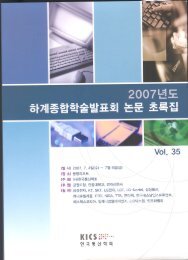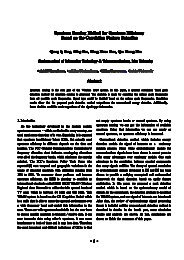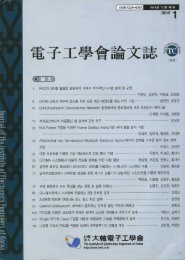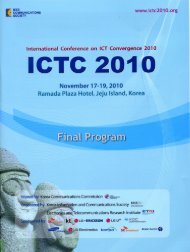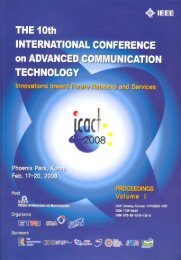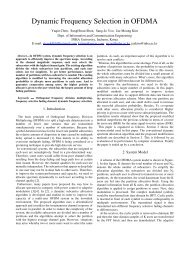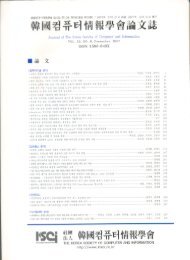The Tag Anti-Collision Algorithm using the Power Increasing Method ...
The Tag Anti-Collision Algorithm using the Power Increasing Method ...
The Tag Anti-Collision Algorithm using the Power Increasing Method ...
Create successful ePaper yourself
Turn your PDF publications into a flip-book with our unique Google optimized e-Paper software.
ICEIC 2008<br />
<strong>The</strong> 9 th International Conference on<br />
Electronics, Information, and Communication<br />
Electronics<br />
Organized by<br />
Sponsored by<br />
Communication<br />
Information<br />
June 24-27, 2008<br />
Tashkent, Uzbekistan<br />
Tashkent University of Information Technologies<br />
<strong>The</strong> Institute of Electronics Engineers of Korea<br />
Communications and Information Agency of Uzbekistan<br />
MKE<br />
IITA<br />
KSF<br />
KOFST<br />
LG Telecom<br />
Samsung Electronics<br />
SK Telecom<br />
KTF<br />
KT<br />
IEEE Seoul Section<br />
IT-SoC Research Center
WE7: Wireless Communication II<br />
7-1 Overhead impact in Multipath Routing for Mobile Ad Hoc Network <strong>using</strong> IEEE<br />
802.11 DCF<br />
7-2 A Comparative Survey of Routing Protocols in Vehicular Ad Hoc Networks 163<br />
7-3 Cross-Layer Designed MAC Protocol for Wireless Sensor Network 168<br />
7-4 Mobile Widget based Advertisement System <strong>using</strong> Push Message Control 172<br />
7-5 An Enhanced <strong>Tag</strong> <strong>Anti</strong>-collision <strong>Algorithm</strong> in Passive RFID Systems by <strong>using</strong><br />
QueryAdjust Command<br />
7-6 <strong>The</strong> <strong>Tag</strong> <strong>Anti</strong>-<strong>Collision</strong> <strong>Algorithm</strong> <strong>using</strong> <strong>the</strong> <strong>Power</strong> <strong>Increasing</strong> <strong>Method</strong> in <strong>the</strong> UHF<br />
RFID System<br />
WE8: Analog/Digital Circuits and Systems II<br />
8-1 A 2GHz DLL-Based Frequency Multiplier for Dynamic Frequency Scaling 186<br />
8-2 A highly Reliable, Low <strong>Power</strong> Non-Volatile Memory Cell Utilizing Localized<br />
Voltage Bootstrapping<br />
8-3 Compact Chip Antenna Using Slot in <strong>The</strong> Patch for Mobile WiBro 194<br />
8-4 Design and Fabrication of Hyperabrupt Varactor Diode on GaAs substrate 197<br />
8-5 LTPS TFT Based High Speed and Low <strong>Power</strong> CMOS Level Shifter 201<br />
8-6 High Speed and Low <strong>Power</strong> Level Shifter Using Only p-channel LTPS TFTs 205<br />
8-7 Compact Active Integrated Antennas Embedded in LTCC Substrates for 5.8 GHz<br />
Wireless LAN Applications<br />
WE9: Digital Image Processing and Graphics II<br />
9-1 Motion Tracking Based on Background Color Rejective Centroids Shifting 213<br />
9-2 Image Fusion Based on <strong>the</strong> Color Difference Domain 217<br />
9-3 Performance Enhancement of Motion Estimation Using SSE2 Technology 221<br />
9-4 <strong>Algorithm</strong> for person identification by facial images 225<br />
9-5 Computation reduction of H.264/AVC motion estimation by search range<br />
adjustment and partial cost evaluation<br />
WE10: IT-business and E-commerce II<br />
10-1 Novel scheduling for business card exchange system with multi users <strong>using</strong> ZigBee 234<br />
10-2 An Analysis of Open Source Business Models 238<br />
10-3 Formation stages of information society 241<br />
10-4 Development of Informational Business in <strong>the</strong> Republic of Uzbekistan 244<br />
159<br />
177<br />
181<br />
190<br />
209<br />
229
Proceedings of ICEIC2008, June 24-27, 2008, Tashkent, Uzbekistan<br />
<strong>The</strong> <strong>Tag</strong> <strong>Anti</strong>-<strong>Collision</strong> <strong>Algorithm</strong> <strong>using</strong> <strong>the</strong> <strong>Power</strong><br />
<strong>Increasing</strong> <strong>Method</strong> in <strong>the</strong> UHF RFID System<br />
You Seok Yim, Joo Kwan Lee, Sung Hwan Shon, and Jae Moung Kim<br />
INHA-WiTLAB, INHA University<br />
253 Youghyun-dong, Nam-gu Incheon 402-751, Korea<br />
ohsomays@naver.com, miraju81@nate.com, kittisn@naver.com, jaekim@inha.ac.kr<br />
Abstract – RFID is that <strong>the</strong> reader detects <strong>the</strong> tag<br />
information attached on <strong>the</strong> objects without contact.<br />
Particularly, <strong>the</strong> negative effects, we called <strong>the</strong> tag-collision,<br />
may occur because <strong>the</strong>re are lots of tags in <strong>the</strong> UHF RFID<br />
system. We should solve <strong>the</strong>se effects and <strong>the</strong> Slotted<br />
Random <strong>Anti</strong>-collision algorithm is presented to prevent <strong>the</strong><br />
tag-collision effect in <strong>the</strong> EPCglobal Gen2 protocol. In this<br />
paper, in order to minimize <strong>the</strong> tag-collision effect and bring<br />
on <strong>the</strong> system efficiency, we propose <strong>the</strong> <strong>Power</strong> <strong>Increasing</strong><br />
<strong>Method</strong> that controls <strong>the</strong> transmission power of <strong>the</strong> reader to<br />
prevent <strong>the</strong> tag collision effects and verifies <strong>the</strong> improved<br />
performance.<br />
1. Introduction<br />
<strong>The</strong> RFID(Radio Frequency Identification) is <strong>the</strong> wireless<br />
technology which detects a lot of tags attached on <strong>the</strong><br />
objects(e.g. things, livings etc.) without contact. <strong>The</strong> RFID<br />
system consist of <strong>the</strong> reader(which detects <strong>the</strong> tag), its antenna,<br />
<strong>the</strong> tag and <strong>the</strong> software which can process <strong>the</strong> information<br />
detected from tags. And <strong>the</strong>re are several types of tags which<br />
are active, passive and semi-types. Basically, <strong>the</strong> active tags<br />
have <strong>the</strong>ir own power and <strong>the</strong> passive tags don’t have own<br />
power. In case of <strong>the</strong> active tags, <strong>the</strong>y have longer<br />
interrogation range but <strong>the</strong>ir size is little big due to <strong>the</strong> battery.<br />
On <strong>the</strong> o<strong>the</strong>r hand, <strong>the</strong> passive tags use <strong>the</strong> power transmitted<br />
from <strong>the</strong> reader and we can make <strong>the</strong>m small and <strong>the</strong>ir price<br />
low. <strong>The</strong>refore, <strong>the</strong>se days <strong>the</strong> passive tags are more popular<br />
in <strong>the</strong> UHF RFID systems for <strong>the</strong>se reason.[1]<br />
Especially, <strong>the</strong> UHF(900MHz) RFID technology attracts<br />
our attention as an alternative of conventional Bar-code<br />
system due to long interrogation distance and <strong>the</strong> ability of<br />
detecting multiple objects simultaneously. But <strong>the</strong>re are lots<br />
of tags to detect in <strong>the</strong> UHF RFID system which applies to <strong>the</strong><br />
Logistics & <strong>the</strong> Distribution industry. If <strong>the</strong> reader tries to<br />
detect multiple tags, <strong>the</strong> tag-collision will occur because more<br />
than two tags respond in <strong>the</strong> same time. <strong>The</strong>se effects cause<br />
<strong>the</strong> loss of <strong>the</strong> system efficiency, thus <strong>the</strong> anti-collision<br />
algorithm is essential to detect multiple tags efficiently.<br />
Although <strong>the</strong>re are lots of anti-collision algorithms and<br />
CSMA etc, <strong>the</strong> slotted random anti-collision algorithm is<br />
introduced in <strong>the</strong> EPCglobal class1 Gen2 protocol.[2]<br />
In this paper, we propose <strong>the</strong> tag anti-collision algorithm<br />
that <strong>the</strong> reader controls its transmission power to detect <strong>the</strong><br />
tags more efficiently and to improve <strong>the</strong> system performance<br />
through changing its recognition coverage. We verify <strong>the</strong>se<br />
effects via <strong>the</strong> computer simulations.<br />
181<br />
2. Conventional <strong>Anti</strong>-<strong>Collision</strong> <strong>Algorithm</strong><br />
In <strong>the</strong> UHF RFID system, <strong>the</strong> multiple tags may be<br />
distributed in certain area as shown in <strong>the</strong> Figure 1. If <strong>the</strong>re<br />
are lots of tags within <strong>the</strong> reader coverage, <strong>the</strong> tag-collision<br />
may occur because <strong>the</strong> tags respond simultaneously to <strong>the</strong><br />
signal which <strong>the</strong> reader transmitted. This effect makes <strong>the</strong><br />
system efficiency low and <strong>the</strong> reader can’t detect <strong>the</strong> tags<br />
correctly. <strong>The</strong>refore, <strong>the</strong> anti-collision algorithm is required<br />
and <strong>the</strong> slotted random anti-collision algorithm mentioned in<br />
<strong>the</strong> EPCglobal class1 Gen2 protocol.<br />
Figure 1: Environment of <strong>the</strong> UHF RFID system<br />
<strong>The</strong> Frame Slotted Aloha(FSA) concept, which is adopted<br />
in <strong>the</strong> RFID system, is shown in <strong>the</strong> Figure 2. Figure 2 shows<br />
us <strong>the</strong> procedure of <strong>the</strong> tag detection partially. Basically, <strong>the</strong><br />
FSA algorithm accesses <strong>the</strong> object by <strong>the</strong> time order and <strong>the</strong><br />
tags determine <strong>the</strong>ir own slot to respond to <strong>the</strong> Query that <strong>the</strong><br />
reader transmit to recognize <strong>the</strong> tag. <strong>The</strong>re are three type of<br />
<strong>the</strong> slot state in <strong>the</strong> FSA algorithm. At first, if only one tag’s<br />
information is inserted in one slot, we called ‘Success’ as you<br />
can see at <strong>the</strong> second slot of <strong>the</strong> frame (N1). And if more than<br />
two tags try to insert <strong>the</strong>ir information into one slot, we called<br />
‘<strong>Collision</strong>’. We can see <strong>the</strong> collision state of <strong>the</strong> slot at <strong>the</strong><br />
third slot of <strong>the</strong> frame (N1) in <strong>the</strong> Figure 2. And if <strong>the</strong>re is no<br />
information on a slot, we called ‘Idle’. We can know <strong>the</strong> idle<br />
state of <strong>the</strong> slot at <strong>the</strong> first slot of <strong>the</strong> frame (N1). As you see<br />
in Figure 2, if <strong>the</strong> tag-collision occurs at <strong>the</strong> third slot of <strong>the</strong><br />
first frame (N1), <strong>the</strong> reader retransmits <strong>the</strong> query to detect<br />
collided tags and repeats <strong>the</strong> procedure until detecting <strong>the</strong> all<br />
tags. We call <strong>the</strong> Query retransmission and <strong>the</strong> reader can<br />
detect <strong>the</strong> collided tags. Although <strong>the</strong> reader tries to detect <strong>the</strong><br />
collided tags again in <strong>the</strong> frame (N2), <strong>the</strong> reader repeatedly<br />
transmits <strong>the</strong> Query if <strong>the</strong> all tags are not recognized.[3][4]
Proceedings of ICEIC2008, June 24-27, 2008, Tashkent, Uzbekistan<br />
Figure 2: <strong>The</strong> Frame Slotted Aloha in <strong>the</strong> RFID system<br />
However, <strong>the</strong>re are some limitations on <strong>the</strong> conventional<br />
FSA algorithm. Let us analyze <strong>the</strong>se reasons ma<strong>the</strong>matically.<br />
Assuming <strong>the</strong> number of assigned slots is ‘S’, <strong>the</strong> probability<br />
‘p’ that <strong>the</strong> tags try to respond at one Frame is defined as<br />
‘p=1/S’.[5] As a view of <strong>the</strong> Binomial Distribution, <strong>the</strong><br />
probability ‘Ps’ that just one tag among <strong>the</strong> total ‘n’ responds<br />
successfully can be expressed as (1). <strong>The</strong> probability ‘Pi’ that<br />
slot will be <strong>the</strong> idle state and <strong>the</strong> probability ‘Pc’ that slot will<br />
be <strong>the</strong> collision state are also expressed as (2) ~ (3).<br />
Figure 3: Comparison of <strong>the</strong> <strong>the</strong>oretical results about <strong>the</strong><br />
collision slot in one frame(S=16)<br />
According to (3), when ‘n’ tags try to respond through ‘S’<br />
slots, <strong>the</strong> number of <strong>the</strong> collision slot in <strong>the</strong> one frame is<br />
(1)<br />
(2)<br />
(3)<br />
<br />
<br />
182<br />
defined as (4). And <strong>the</strong>n Figure 3 shows <strong>the</strong> results about<br />
calculating <strong>the</strong> equation (4) with 16 slots.<br />
As shown in Figure 3, if <strong>the</strong> number of tags increases, <strong>the</strong><br />
number of collision slots increases radically. <strong>The</strong> more tags<br />
exist, <strong>the</strong> more slot usage for detecting all <strong>the</strong> tags will be<br />
needed due to large number of repetition(retransmission)<br />
frames. It causes not only <strong>the</strong> delay of detecting time in <strong>the</strong><br />
system but also <strong>the</strong> large decline of <strong>the</strong> system efficiency.<br />
3. Proposed Scheme<br />
In conventional anti-collision algorithm(FSA), <strong>the</strong> reader<br />
repeatedly transmits <strong>the</strong> Query <strong>using</strong> 1W transmission power<br />
to detect all tags including <strong>the</strong> collided ones. But, in order to<br />
overcome <strong>the</strong> limitation of <strong>the</strong> conventional algorithm which<br />
is described in <strong>the</strong> second section, we propose a step by step<br />
tag detection scheme defined as <strong>the</strong> <strong>Power</strong> <strong>Increasing</strong><br />
<strong>Method</strong>(PIM). In order to describe <strong>the</strong> proposed algorithm in<br />
detail, <strong>the</strong> assumed environment and <strong>the</strong> detection procedure<br />
of detecting <strong>the</strong> tags are drawn in Figure 4 and <strong>the</strong> Figure 5.<br />
First of all, we assume that <strong>the</strong> tags are distributed uniformly<br />
and <strong>the</strong> tags which are successfully detected once do not<br />
respond upon retransmission of <strong>the</strong> reader.<br />
Figure 4: RFID system environment for <strong>the</strong> PIM<br />
Briefly saying, <strong>the</strong> reader transmits <strong>the</strong> Query with certain<br />
power up to dotted-line area for <strong>the</strong> first step and tries to<br />
detect remained tags by transmitting <strong>the</strong> Query up to dashedline<br />
area. In <strong>the</strong> second step, <strong>the</strong> reader increases its<br />
transmission power and transmits <strong>the</strong> Query up to broken-line<br />
area. And <strong>the</strong>n, <strong>the</strong> reader increases its transmission power to<br />
1W up to <strong>the</strong> solid line which is maximum interrogation area<br />
of <strong>the</strong> reader. But if <strong>the</strong> collided tags are remained in <strong>the</strong><br />
reader’s interrogation area, <strong>the</strong> reader transmits <strong>the</strong> Query<br />
with 1W again.<br />
First of all, in order to realize as remarked above<br />
practically, <strong>the</strong> recognition distance of <strong>the</strong> reader in <strong>the</strong> sense<br />
<br />
(4)
Proceedings of ICEIC2008, June 24-27, 2008, Tashkent, Uzbekistan<br />
of <strong>the</strong> free space model(multipath propagation isn’t<br />
considered due to <strong>the</strong> short distance) is expressed as<br />
where ‘Preader’ is <strong>the</strong> reader transmission power, ‘Greader’ and<br />
‘Gtag’ are antenna gains of each reader and tag, ‘Ptmin’ is<br />
receiving sensitivity of tag and ‘ is wavelength.[6]<br />
From (5), <strong>the</strong> required reader transmission power which can<br />
be used to transmit <strong>the</strong> Query up to distance ‘dreader’ is<br />
expressed as (6).<br />
Table 1: <strong>The</strong> reader transmission power with 4 steps for PIM<br />
Steps Each Distance[m] <strong>Power</strong>[W]<br />
1 st<br />
1.3 0.062<br />
2 nd<br />
2.6 0.248<br />
3 rd<br />
3.9 0.557<br />
4 th<br />
5.2 1<br />
According to <strong>the</strong> (6), we can calculate <strong>the</strong> required power<br />
for <strong>the</strong> each step of <strong>the</strong> PIM and result of <strong>the</strong> calculation<br />
under <strong>the</strong> four power step of <strong>the</strong> PIM is indicated at Table 1.<br />
At this time, <strong>the</strong> maximum recognition distance is calculated<br />
5.2m under <strong>the</strong> Table 2 conditions. And we assume that <strong>the</strong><br />
each recognition distance for <strong>the</strong> PIM is 1.3m.<br />
Table 2: <strong>The</strong> parameters for <strong>the</strong> computer simulation<br />
Parameters Value<br />
Frequency 914 MHz<br />
Reader Transmission <strong>Power</strong> 1 W(Maximum)<br />
Reader Antenna Gain 6 dBi<br />
<strong>Tag</strong> Antenna Gain 0 dBi<br />
<strong>Tag</strong> Receiving Sensitivity 0.1 mW<br />
<strong>The</strong> number of tags 1 ~ 100<br />
<strong>The</strong> number of slots 16<br />
And <strong>the</strong>n, in order to understand <strong>the</strong> PIM algorithm in<br />
detail. Figure 5 shows us <strong>the</strong> procedure of <strong>the</strong> detecting <strong>the</strong><br />
tags with PIM. Examining Figure 5 carefully with Figure 4,<br />
<strong>the</strong> reader tries to detect <strong>the</strong> tags in <strong>the</strong> 1 st line domain(dottedline<br />
in <strong>the</strong> Figure 5). And <strong>the</strong> reader detects <strong>the</strong> tags up to <strong>the</strong><br />
2 nd line domain. At this step, <strong>the</strong> collided tags in <strong>the</strong> 1 st<br />
domain also have to be detected. <strong>The</strong> reader increases its<br />
transmission power up to maximum and tries to detect <strong>the</strong><br />
remained tags in <strong>the</strong> whole interrogation area. But if all tags<br />
aren’t detected until this step, <strong>the</strong> reader transmits <strong>the</strong> signal<br />
with its maximum transmission power again to detect <strong>the</strong> all<br />
tags perfectly.<br />
(5)<br />
(6)<br />
183<br />
Figure 5: Comparison with <strong>the</strong> results of <strong>the</strong> ma<strong>the</strong>matical<br />
derivation and <strong>the</strong> simulation for <strong>the</strong> slot usage for PIM<br />
4. Performance Analysis<br />
In order to verify <strong>the</strong> performance of <strong>the</strong> PIM, <strong>the</strong><br />
computer simulations are made via <strong>the</strong> Table 2. We have <strong>the</strong><br />
three kinds of <strong>the</strong> simulation results and <strong>the</strong>y can describe <strong>the</strong><br />
better system performance.<br />
First of all, in order to compare <strong>the</strong> slot usage(that <strong>the</strong><br />
reader totally used during detecting <strong>the</strong> all tags) for <strong>the</strong><br />
conventional FSA and <strong>the</strong> PIM, <strong>the</strong> results are indicated at <strong>the</strong><br />
Figure 6.<br />
Figure 6: Comparison of <strong>the</strong> slot usage for <strong>the</strong> conventional<br />
FSA and <strong>the</strong> PIM<br />
As you can see in <strong>the</strong> Figure 6, <strong>the</strong> PIM algorithm<br />
indicates <strong>the</strong> better performance more than 33 tags.<br />
Particularly, in case of <strong>the</strong> 90 tags, <strong>the</strong> PIM help <strong>the</strong> RFID<br />
system improve about 34% in <strong>the</strong> sense of <strong>the</strong> slot usage.<br />
For <strong>the</strong> next step, let us look into ano<strong>the</strong>r simulation result<br />
which is related to <strong>the</strong> collision frequency. <strong>The</strong> collision<br />
frequency is how many collisions occur during recognizing<br />
<strong>the</strong> all tags in <strong>the</strong> reader’s coverage. <strong>The</strong> high collision<br />
occurrence means that <strong>the</strong> number of <strong>the</strong> retransmission is<br />
increasing and <strong>the</strong> time is delayed to detect <strong>the</strong> tags perfectly.
Proceedings of ICEIC2008, June 24-27, 2008, Tashkent, Uzbekistan<br />
<strong>The</strong> Figure 7 shows us <strong>the</strong> results about <strong>the</strong> collision<br />
frequency in case of <strong>the</strong> conventional FSA and <strong>the</strong> proposed<br />
algorithm.<br />
Figure 7: Comparison of <strong>the</strong> collision frequency for <strong>the</strong><br />
conventional FSA and <strong>the</strong> PIM<br />
According to <strong>the</strong> Figure 7, <strong>the</strong> PIM indicates <strong>the</strong> better<br />
performance more than <strong>the</strong> FSA. <strong>The</strong> PIM algorithm starts to<br />
perform better over about 14 tags. And in case of <strong>the</strong> 100 tags,<br />
<strong>the</strong> PIM can bring on <strong>the</strong> RFID system’s efficiency about<br />
35% comparing to <strong>the</strong> FSA algorithm. So we can know that<br />
<strong>the</strong> PIM algorithm lead <strong>the</strong> system efficiency higher.<br />
Figure 8: Comparison of <strong>the</strong> power consumption for <strong>the</strong><br />
conventional FSA and <strong>the</strong> PIM<br />
Finally, in aspect of <strong>the</strong> power consumption, we can think<br />
that lots of retransmissions in <strong>the</strong> certain system make <strong>the</strong><br />
system inefficient and also consume <strong>the</strong> large amount of <strong>the</strong><br />
power. Figure 8 shows us <strong>the</strong>se kinds of <strong>the</strong> situation.<br />
Because <strong>the</strong> PIM uses less power, it can give <strong>the</strong> RFID reader<br />
184<br />
more long <strong>using</strong> time. We can confirm that <strong>the</strong> reader with<br />
PIM algorithm can consume less power than conventional<br />
FSA over about 12 tags. Although <strong>the</strong> performance of <strong>the</strong><br />
PIM isn’t good for very small number of tags, <strong>the</strong> PIM gives<br />
us <strong>the</strong> great improvement for <strong>the</strong> large number of <strong>the</strong> tags.<br />
<strong>The</strong>refore, we can think that <strong>the</strong>se results will support <strong>the</strong><br />
UHF RFID system more efficiently.<br />
5. Conclusions<br />
In this paper, we propose <strong>the</strong> tag anti-collision algorithm<br />
with <strong>the</strong> <strong>Power</strong> <strong>Increasing</strong> <strong>Method</strong>. As you can confirm via<br />
<strong>the</strong> three kinds of <strong>the</strong> simulation results, <strong>the</strong> proposed<br />
algorithm is able to make <strong>the</strong> system efficiency enhanced up.<br />
And <strong>the</strong>n, it can be adopted easily for Logistics &<br />
Distribution Industry because <strong>the</strong> proposed algorithm<br />
indicates high performance in large number of tags. But <strong>the</strong><br />
proposed algorithm does not indicate <strong>the</strong> better performance<br />
than <strong>the</strong> FSA under <strong>the</strong> small number of <strong>the</strong> tags. Thus, in<br />
order to make <strong>the</strong> overall RFID system more efficient, <strong>the</strong><br />
additional researches under <strong>the</strong> small number of tags have to<br />
be executed.<br />
Acknowledgments<br />
This work was supported by Korea Science &<br />
Engineering Foundation(KOSEF) through <strong>the</strong> National<br />
Research Lab. Program funded by <strong>the</strong> Ministry of Science<br />
and Technology(M10600000194-06J0000-19410).<br />
And this research also was supported by <strong>the</strong><br />
MKE(Ministry of Knowledge Economy), Korea, under <strong>the</strong><br />
ITRC(Information Technology Research Center) support<br />
program supervised by <strong>the</strong> IITA(Institute of Information<br />
Technology Assessment) (IITA-2008-C1090-0801-0019).<br />
References<br />
1. Giuseppe De V., Giuseppe I., “Design criteria for <strong>the</strong> RF<br />
section of UHF and microwave passive RFID<br />
Transponders”, IEEE Trans- MTAT, Vol. 53 (2005), pp.<br />
2978-2990<br />
2. EPCglobal., “EPCTM Radio-Frequency Identity Protocols<br />
Class-1 Generation-2 UHF RFID Protocol for<br />
Communications at 860MHz to 960MHz Version 1.0.9”<br />
(2005)<br />
3. Frits C. Schoute., “Control of ALOHA Signaling in a<br />
Mobile Radio Trucking Systems. In International<br />
Conference on Radio Spectrum Conservation Techniques”,<br />
IEE (1980) pp. 38-42<br />
4. Frits C. Schoute, "Dynamic Frame Length ALOHA",<br />
IEEE Transactions on Communications, COM31(4), April<br />
(1983), pp. 565-568<br />
5. Jae-Ryong Cha., Jae-Hyun Kim., “ALOHA-type <strong>Anti</strong>collision<br />
<strong>Algorithm</strong> Using <strong>Tag</strong> Estimation <strong>Method</strong> in<br />
RFID system.”, IEEK Magazine, Vol.30 (2005), pp. 814-<br />
821
Proceedings of ICEIC2008, June 24-27, 2008, Tashkent, Uzbekistan<br />
6. Byoung-Tae Yun., Yong-Jin Kim., Sung-Soo Lee.,<br />
Young-Il Kim., “Read Range of Mobile RFID.”, KEES<br />
Magazine, Vol.16 (2005), pp. 61-66<br />
185



